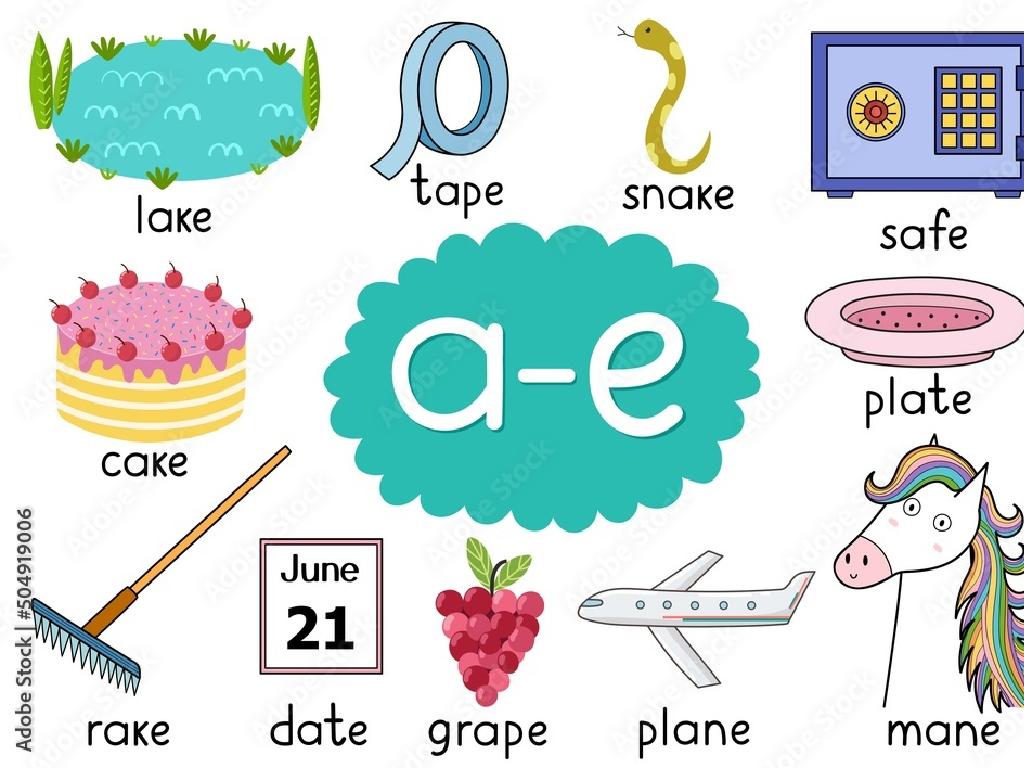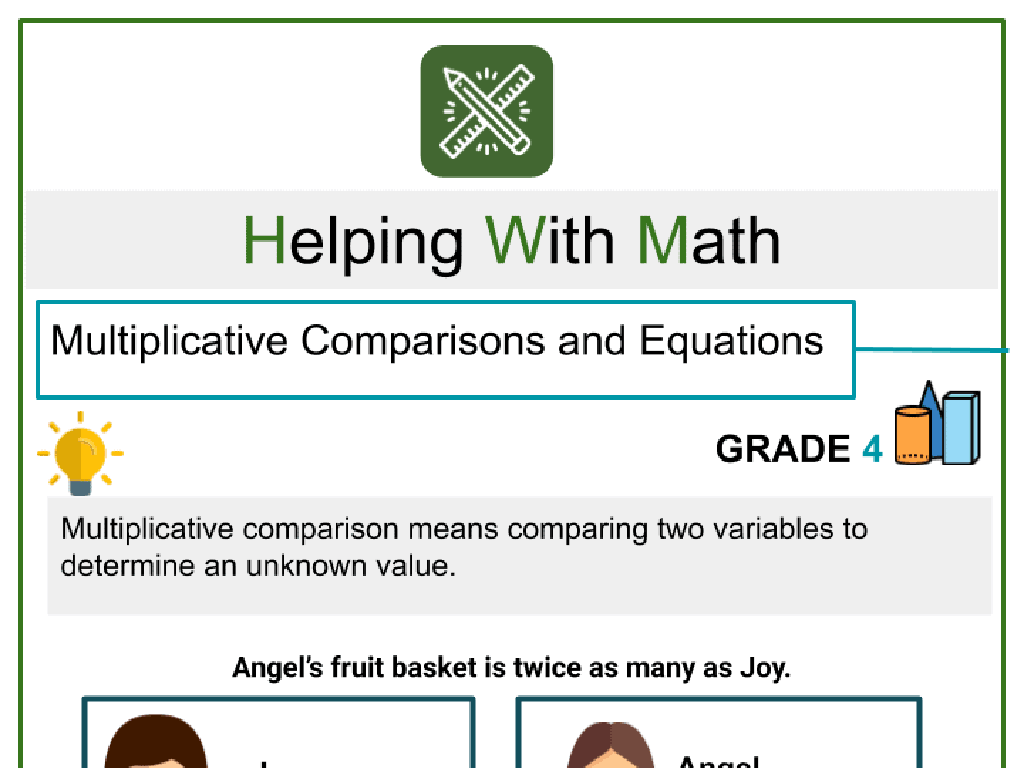Complete Addition And Subtraction Equations With Integers
Subject: Math
Grade: Seventh grade
Topic: Operations With Integers
Please LOG IN to download the presentation. Access is available to registered users only.
View More Content
Operations with Integers: Addition & Subtraction
– Integers in daily life
– Integers are used in temperature, banking, and elevations.
– Defining integers
– Integers include whole numbers, their opposites, and zero.
– Rules for adding integers
– To add, same signs sum up, different signs subtract.
– Rules for subtracting integers
– To subtract, add the opposite of the number being subtracted.
|
This slide introduces students to the concept of integers and their practical applications in everyday life, such as in temperature readings, financial transactions, and measuring elevation. Integers are defined as whole numbers, their opposites, and zero. The slide then focuses on the rules for adding and subtracting integers, highlighting the importance of understanding the sign of the numbers involved. For addition, if the integers have the same sign, their absolute values are added together, and the common sign is kept. If they have different signs, their absolute values are subtracted, and the sign of the larger absolute value is kept. For subtraction, the key is to add the additive inverse (opposite) of the integer being subtracted. Provide examples for each rule to ensure comprehension. Encourage students to practice these operations with real-life examples.
Understanding Integers
– Integers: Positive, negative, and zero
– Whole numbers without fractions or decimals
– Examples: -3, 0, 4, 15
– Use these to practice addition and subtraction
– Integers exclude fractions/decimals
– Integers in addition/subtraction
– Apply integer rules to solve equations
|
Integers are the building blocks of math, especially when dealing with operations like addition and subtraction. They include all whole numbers, both positive and negative, as well as zero. It’s crucial to note that integers do not include fractions or decimals. When performing operations, understanding that integers can be negative or positive is key to solving equations correctly. Provide examples of simple addition and subtraction equations using integers to illustrate how they work. Encourage students to think of real-life scenarios where they use integers, such as temperatures above and below zero, to make the concept more relatable.
Visualizing Integers on a Number Line
– Use a number line for integer placement
– A number line helps us see the position of numbers relative to each other.
– Positive integers: move right of zero
– Each step to the right increases the value by 1 (e.g., 0 to 1, 1 to 2).
– Negative integers: move left of zero
– Each step to the left decreases the value by 1 (e.g., 0 to -1, -1 to -2).
– Practice with addition and subtraction
– Let’s add and subtract integers using the number line as a visual aid.
|
This slide introduces students to the concept of visualizing integers using a number line, which is a foundational skill in understanding operations with integers. Emphasize the importance of the number line in identifying the relative position of integers, with positive integers located to the right of zero and negative integers to the left. Encourage students to think of the number line as a horizontal path where movement to the right signifies an increase and to the left signifies a decrease in value. Provide examples of simple addition and subtraction problems and demonstrate how to use the number line to find the answers. For instance, show how adding a positive integer moves the point to the right, while subtracting moves it to the left. This visual approach will help students grasp the concept of integer operations more concretely.
Rules for Adding Integers
– Adding same sign integers
– Sum the values and keep the original sign, e.g., (-3) + (-2) = -5
– Adding different sign integers
– Find the difference and use the sign of the larger, e.g., (-3) + 4 = 1
– Subtract and adopt the larger number’s sign
– Utilize number line for addition
– A visual method to understand integer addition
|
When teaching integer addition, start by explaining that the rules change depending on the signs of the numbers involved. If the integers have the same sign, simply add the absolute values and keep the sign. For integers with different signs, subtract the smaller absolute value from the larger one and take the sign of the integer with the larger absolute value. Emphasize that a number line can be a helpful tool for visualizing these concepts, especially for students who are visual learners. Provide several examples for each rule and encourage students to practice using a number line to solidify their understanding.
Rules for Subtracting Integers
– Keep, Change, Change rule
– Keep the first number, switch subtraction to addition, and flip the second number s sign.
– Subtracting negatives equals addition
– When you subtract a negative, it’s the same as adding a positive number.
– Use a number line for subtraction
– Visualize moving backwards on the number line to subtract.
– Practice with examples
– Let’s try -5 – (-3) and 7 – 4 using these rules.
|
This slide introduces students to the rules for subtracting integers, an essential concept in 7th-grade math. The ‘Keep, Change, Change’ method is a mnemonic that helps students remember the steps to convert a subtraction problem into an addition one, which is often easier to solve. Emphasize that subtracting a negative number is the same as adding its positive counterpart. Using a number line can help students visualize the process of subtraction, especially when dealing with negative integers. Provide practice problems to apply these rules, such as -5 – (-3) which becomes -5 + 3, and 7 – 4. Encourage students to use these strategies on their homework and classwork to become more comfortable with integer operations.
Solving Addition Problems with Integers
– Example 1: 7 + (-3)
– Positive plus negative, think of gaining and losing
– Example 2: -5 + (-8)
– Adding two negatives, like going further into debt
– Example 3: -4 + 10
– Negative plus a larger positive, results in a positive
– Understanding integer addition
|
This slide presents three examples of addition problems involving integers, which will help students understand how to work with positive and negative numbers. Example 1 demonstrates adding a negative number to a positive, which can be thought of as gaining and then losing something. Example 2 shows the addition of two negative numbers, similar to accumulating more debt. Example 3 illustrates adding a negative number to a larger positive number, resulting in a positive outcome. Encourage students to visualize these concepts with real-life scenarios, such as financial transactions. The goal is to make them comfortable with the idea that integers can represent gains or losses, and how these can be combined through addition.
Solving Subtraction Problems with Integers
– Example 1: Subtracting a negative
– 9 – (-2) = 9 + 2 = 11
– Example 2: Subtracting a positive from a negative
– -6 – 3 = -6 + (-3) = -9
– Example 3: Negative minus a negative
– -15 – (-5) = -15 + 5 = -10
– Practice these subtraction types
|
This slide focuses on subtraction problems involving integers, which can be tricky for students at first. Start with explaining that subtracting a negative is the same as adding its positive counterpart. For example 1, show that 9 – (-2) turns into 9 + 2. In example 2, illustrate that when you subtract a positive number from a negative, you move further left on the number line, hence -6 – 3 equals -9. For example 3, explain that subtracting a negative is like adding a positive, so -15 – (-5) becomes -15 + 5. Encourage students to practice these concepts with additional problems to build their confidence and understanding.
Practice Time: Addition & Subtraction with Integers
– Try solving problems on your own
– Pair up for practice problems
– Work together and help each other out
– Discuss problem-solving strategies
– Did you use number lines or rules for +/- integers?
– Share solutions with the class
|
This slide is designed to engage students in active practice of adding and subtracting integers. Encourage them to attempt solving problems individually first to assess their understanding. Then, have them pair up to tackle practice problems together, fostering collaboration and peer learning. As they work, they should discuss the strategies they use, such as visual aids like number lines or memorized rules for combining positive and negative numbers. After the activity, create an opportunity for pairs to share their solutions and the thought process behind them with the class. This will help reinforce their learning and allow you to address any common misconceptions. Possible activities could include solving equations, word problems, or creating their own problems for others to solve.
Class Activity: Integer Operations Race
– Split into teams for a math challenge
– Solve integer addition and subtraction
– Use number lines or integer rules
– First team to finish wins a prize
– Discuss strategies post-race
– Share problem-solving techniques used
|
This activity is designed to encourage teamwork and quick thinking as students work together to solve integer addition and subtraction problems. Before starting, review the rules for adding and subtracting integers. Divide the class into small teams, distribute a set of problems, and set a timer. The first team to finish with all correct answers wins a small prize. After the race, lead a discussion where each team reflects on the strategies they used to solve the problems efficiently. This could include using a number line, applying integer rules, or checking each other’s work for mistakes. The goal is to reinforce their understanding of integer operations and to share different approaches to problem-solving.
Wrapping Up: Integers Addition & Subtraction
– Review of integer operations
We revisited adding and subtracting with negative and positive numbers.
– Open floor for questions
– Homework assignment
Finish the provided worksheet on adding and subtracting integers.
– Encouragement for practice
Practice makes perfect! Try to challenge yourself with extra problems.
|
As we conclude today’s lesson on integer operations, it’s important to summarize the key points we’ve covered, including the rules for adding and subtracting positive and negative numbers. Allow time for students to ask any lingering questions or seek clarification on any concepts they’re still unsure about. For homework, students are expected to complete the worksheet that provides a variety of problems on integer operations. This will help reinforce their understanding and provide practice in solving these types of equations. Encourage students to not only complete the worksheet but also to challenge themselves with additional problems if they feel confident. Remind them that consistent practice is crucial for mastering math skills.





